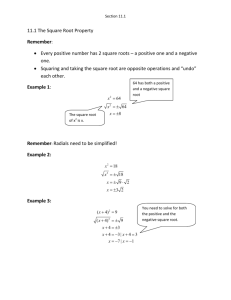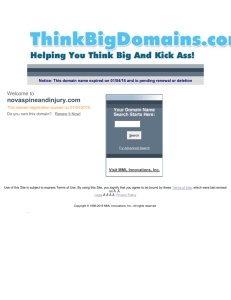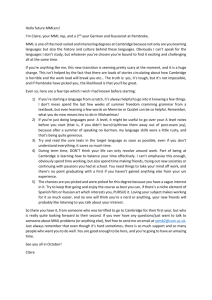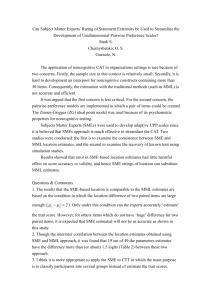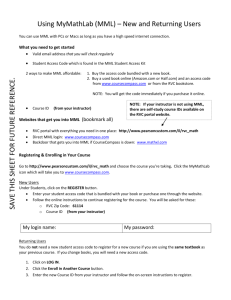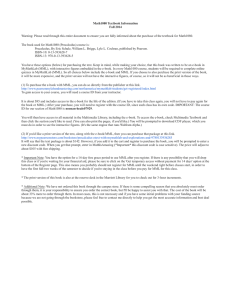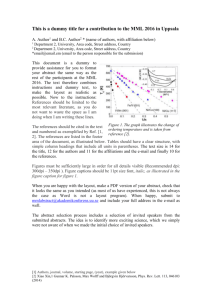Document 13136567
advertisement
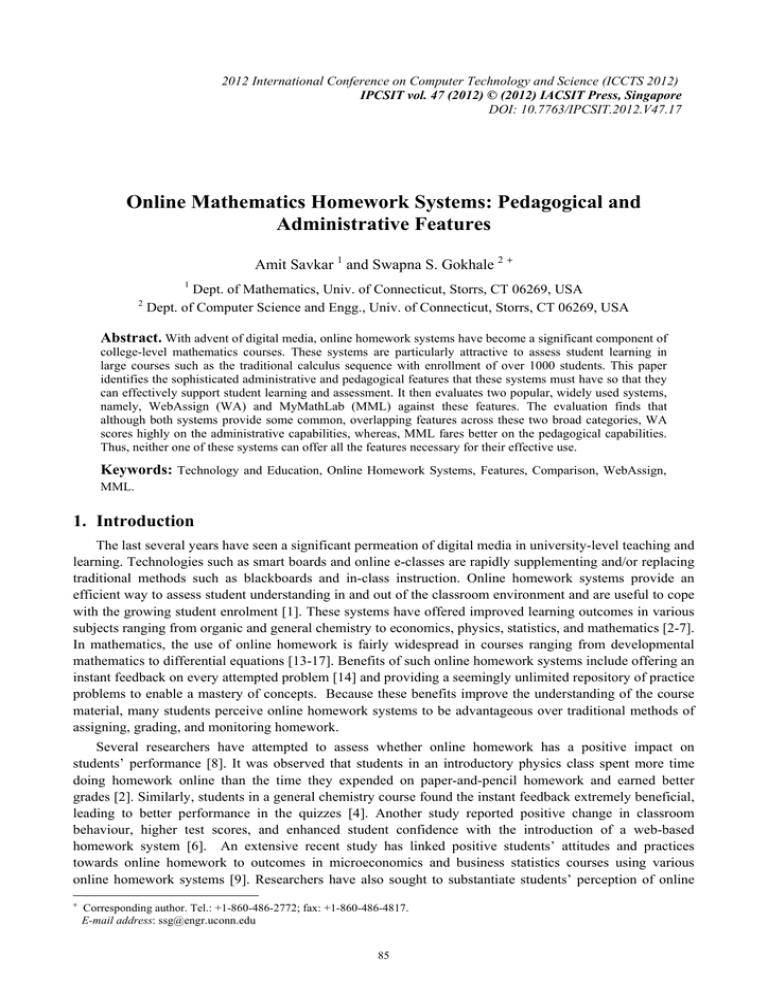
2012 International Conference on Computer Technology and Science (ICCTS 2012) IPCSIT vol. 47 (2012) © (2012) IACSIT Press, Singapore DOI: 10.7763/IPCSIT.2012.V47.17 Online Mathematics Homework Systems: Pedagogical and Administrative Features Amit Savkar 1 and Swapna S. Gokhale 2 + 1 2 Dept. of Mathematics, Univ. of Connecticut, Storrs, CT 06269, USA Dept. of Computer Science and Engg., Univ. of Connecticut, Storrs, CT 06269, USA Abstract. With advent of digital media, online homework systems have become a significant component of college-level mathematics courses. These systems are particularly attractive to assess student learning in large courses such as the traditional calculus sequence with enrollment of over 1000 students. This paper identifies the sophisticated administrative and pedagogical features that these systems must have so that they can effectively support student learning and assessment. It then evaluates two popular, widely used systems, namely, WebAssign (WA) and MyMathLab (MML) against these features. The evaluation finds that although both systems provide some common, overlapping features across these two broad categories, WA scores highly on the administrative capabilities, whereas, MML fares better on the pedagogical capabilities. Thus, neither one of these systems can offer all the features necessary for their effective use. Keywords: Technology and Education, Online Homework Systems, Features, Comparison, WebAssign, MML. 1. Introduction The last several years have seen a significant permeation of digital media in university-level teaching and learning. Technologies such as smart boards and online e-classes are rapidly supplementing and/or replacing traditional methods such as blackboards and in-class instruction. Online homework systems provide an efficient way to assess student understanding in and out of the classroom environment and are useful to cope with the growing student enrolment [1]. These systems have offered improved learning outcomes in various subjects ranging from organic and general chemistry to economics, physics, statistics, and mathematics [2-7]. In mathematics, the use of online homework is fairly widespread in courses ranging from developmental mathematics to differential equations [13-17]. Benefits of such online homework systems include offering an instant feedback on every attempted problem [14] and providing a seemingly unlimited repository of practice problems to enable a mastery of concepts. Because these benefits improve the understanding of the course material, many students perceive online homework systems to be advantageous over traditional methods of assigning, grading, and monitoring homework. Several researchers have attempted to assess whether online homework has a positive impact on students’ performance [8]. It was observed that students in an introductory physics class spent more time doing homework online than the time they expended on paper-and-pencil homework and earned better grades [2]. Similarly, students in a general chemistry course found the instant feedback extremely beneficial, leading to better performance in the quizzes [4]. Another study reported positive change in classroom behaviour, higher test scores, and enhanced student confidence with the introduction of a web-based homework system [6]. An extensive recent study has linked positive students’ attitudes and practices towards online homework to outcomes in microeconomics and business statistics courses using various online homework systems [9]. Researchers have also sought to substantiate students’ perception of online + Corresponding author. Tel.: +1-860-486-2772; fax: +1-860-486-4817. E-mail address: ssg@engr.uconn.edu 85 homework and have noted a significant positive impact on final exam scores [10,11] and on student satisfaction and learning [12]. Several commercial online homework systems are available for various mathematics subjects ranging from Finite Mathematics and the calculus sequence from differentiable through vector calculus. As such, these systems efficiently support the basic tasks of assigning and grading homework and providing instant feedback. However, if these systems are equipped with advanced administrative and pedagogical capabilities, they could lend significant support to both the instructors and the students. In this paper, we discuss these advanced features of online homework systems. Subsequently, we evaluate two widely used, popular online homework systems, namely, WebAssign (WA) [19] and MyMathLab (MML) [20] against these features, based on our five-year long experience in their use in the calculus courses at the University of Connecticut. We find that MML offers many desired pedagogical features, whereas, WA offers many desired administrative features. Thus, each one of these widely used and popular homework system is deficient in one respect. We conclude the paper with a suggestion to enhance WebWork [18], an open source online homework system, to provide a combination of these two types of features. The rest of the paper is organized as follows. Section 2 lists the desired features. Section 3 presents the evaluation of WA and MML. Section 4 concludes the paper and offers directions for future work. 2. Advanced Features The features of an online homework system can be broadly categorized into two types, pedagogical and administrative; the former improves students’ learning process whereas the latter support efficient and effective course management. 2.1. Pedagogical Features The objective of the advanced pedagogical features is to guide the students along a path that enables them to master concepts while producing correct answers to the assigned questions. To meet these pedagogical objectives, an online homework system should offer: • • • • • Ability to view previous incorrect answers from each attempt. Clear and visible count of the number of attempts remaining to solve a given question. Modifying or revising the problems after they are assigned. Rescoring of the problems that may be revised due to errors or other reasons. Feedback on why a problem is incorrect. For example, the system should differentiate between syntactical and conceptual errors, and provide adequate information for students to recover from their mistakes. 2.2. Administrative Features The advanced administrative features will ease the management of large mathematics courses. Usually, these courses follow a hierarchical, three-tier organization consisting of a Coordinator at the top who assumes responsibility for all the sections of the course, as shown in Figure 1. At the second level, there are 4 to 5 large lecture sections taught by individual professors. Finally, at the third level, each large lecture section is further split into smaller discussion sections of 15 students; each section is supervised by a Teaching Assistant (TA). Many of these courses are mandatory for students who receive a BS degree (engineering and sciences), and hence, typically enroll over 1000 students each semester. This hierarchical organization makes it extremely complicated to assign and monitor homework uniformly and consistently to all the students. Thus, to support this organization, an online homework system should offer the ability to: • • • • • • Login and navigate the site in a simple, intuitive manner. Create and maintain a hierarchy of multiple classes, with each class divided into subsections. Manage each class by an instructor and a section coordinator. Manage each subsection by a TA in addition to the instructor. Provide full control of the classes to the instructor, including oversight over the role of the TAs. Equip the coordinator with the mechanisms to control and change assignments on the fly. Integrate with the university’s learning management system (blackboard). 86 (Calculus 1, Calculus 2) Coordinator Large Lecture 1 Large Lecture 2 Large Lecture 3 Large Lecture 4 Large Lecture 5 Discussion section 1 through 10 Discussion section 11 Discussion section 21 Discussion section 31 Discussion section 41 through 20 through 30 through 40 through 50 Figure 1 Hierarchical organization of large mathematics courses. It is important to note that some features do not neatly fit into any one category. For each such feature, we determine whether it strongly influences the pedagogical or the administrative process, and then classify it accordingly. For example, modifying and rescoring assignments can either be an administrative or a pedagogical feature, however, because it has a stronger influence on student learning rather than course management, we classify it as a pedagogical feature. 3. Evaluation of Systems We evaluate two popular online HW Systems, namely, WebAssign (WA) [19] and MyMathLab (MML) [20] from Pearson against the advanced features outlined in Section 2. WA is one of the most widely used, standalone online homework systems. It simultaneously supports over 500,000 users spread over 1500 colleges [19]. MML is even more widely used across several different disciplines with over 7.2 million users [20]. As such, we chose these two systems because of their widespread use in the higher education industry. 3.1. Pedagogical Features Pedagogically, the foremost significant difference between WA and MML is the way in which they store students’ answers to a question. If a student has three attempts to solve a question, WA stores all the answers thus providing a history of students’ attempts. Such history provides critical insights into a student’s evolving thought process while solving a question. It also signals the student to seek help from the TA or the instructor on how to approach the problem correctly, as the number of remaining attempts dwindles. MML, however, lacks this feature. In WA, assignments can be easily modified, even while the students are attempting the problems. Such ease of modification is particularly useful, because some questions become mathematically inappropriate or incorrect, when they are subjected to randomization in order to produce different versions of the problem to test a concept. Randomization of problems, however, is necessary to minimize the cross talk and collaboration among students and to permit a fairer evaluation. These issues, brought about by randomization, surface only after the students start working on the problems. In this case, the instructor or the TA either needs to modify the assignment to eliminate the inappropriate question, or incorporate another problem generated with new randomization settings. The instructor may also decide to add other questions after eliminating the incorrect one. MML does not allow either the TA, or the instructor to change the assignment once the students start working on it. This is extremely restrictive as it limits the possibility of changing a homework after it is assigned, even when it is erroneous. The modified assignment also needs to be re-scored. WA allows such re-scoring, while MML does not. The only work around in MML is to duplicate the existing assignment, then make the necessary change, and re-assign it to the students. It also requires the coordinators, lecturers or the TAs to un-assign the original assignment so that students do not continue to work on the older version. 87 One of better features of MML is that it can distinguish between syntax and conceptual errors, at least for some types of questions. Students find this feedback extremely helpful to correct their answers. WA does not distinguish between these two types of errors, which causes frustration among the students and leads them to waste their time. MML also allows students to scan and upload their handwritten work as images. Instructors can thus view students’ work to serve two purposes; assigning grades and understanding grasp of the material. WA currently does not offer this feature. Finally, the issue of establishing equivalence among answers is critical in mathematics. An answer entered in the form of a reduced fraction and one, which is left in its original form, needs to be evaluated for equivalence. Both systems have limitations with respect to this feature. 3.2. Administrative Features The hierarchical organization shown in Fig. 1 suggests that an online homework system must possess two types of administrative features for smooth operation of students’ assessment. These include: a) Course setup and student enrollment; and b) Homework oversight and content management. Course Setup and Enrollment: WA allows administrators (professors or IT administrators) to create courses and subsections for any number of users with considerable ease. For example, the structure shown in Figure 1 can be designed in WA in just over two minutes. MML, on the other hand, requires extensive use of IT resources and takes over a week for set up. In WA, either students can self enroll, or instructors can upload rosters to enroll the students. In the first option, students register themselves into a particular section through WA website. They choose their own username and password to setup their account for doing online homework. If instructors choose to upload the rosters, then the username and password for each student must be entered as separate column in a CSV or an Excel file. MML requires extensive involvement of the IT staff both at the university and the company to upload student rosters. This significantly restricts its use to support a model that uses batch loading to enroll students. MML offers a separate platform known as MML plus which allows batch loading. Although cumbersome, this model has fared better during its use at the University of Connecticut than MML. Another important administrative feature is the ability to clearly define roles, which is necessary to maintain the hierarchy shown in Figure 1. WA can identify and distinguish between instructor, TA and student roles. Administrative privileges to create or change an assignment, enroll new users, switch users between sections, grant extension for homework etc., are well classified. WA requires each role to have only one login and password. Thus, the system recognizes a TA, who is logged in using the designated name and the password for that role and grants appropriate access. WA is thus significantly conducive to maintaining the structure in Figure 1. MML requires the TAs to have separate admin accounts to enroll or switch users. It is also commonly known that both systems can provide a building block that can integrate with a university’s learning management system (blackboard). Homework Oversight and Content Management: Both WA and MML allow TAs to access student rosters and to grant extensions to homework and quizzes to an individual or a group of students fairly easily. MML differs in this aspect. Another important content management feature is the propagation of common assignments to all sections of all large lecture classes. A coordinator creates a master assignment in a master course, which must then be propagated to all the other subsections of the course. For such propagation, it is absolutely necessary to establish a parent-child relationship between the course and its subsections so that any change in the master assignment is reflected through all the subsections. Such a parent-child relationship can be created in WA relatively easily. MML, on the other hand, requires each course to be copied in a string of operations. It is possible for errors to creep in while referencing the parent course. If and when such an error occurs, it is extremely difficult to fix it without physically un-enrolling the students from the subsections, deleting the incorrectly coded subsection, recreating the subsections with accurate cross talk between the subsections and master course, and then re-enrolling the students. Thus, in MML this process requires extensive IT resources and is very susceptible to human error. Table 1 summarizes the comparative evaluation of WA and MML. A 9 indicates that the system offers the specific feature in a easy, user-friendly manner, while a 8 indicates that it either does not offer the feature 88 at all, or even if it does it is resource-intensive, cumbersome and error prone. In summary, WA scores highly on the administrative features, whereas, MML scores well in the pedagogical category. Table 1 Feature comparison ofWA vs MML Pedagogical Administrative MML WA Homework Management 9 9 Modifying Assignment 8 9 Rescoring Assignment 8 9 Feedback on questions 9 8 Syntax vs. conceptual errors 9 8 History of answers 8 9 Number of remaining attempts 8 9 Hierarchy of roles 8 9 Parent-child relationship 8 9 Self-enrolling 9 9 Roster upload 8 9 Privileges assignment 8 9 LMS integration 9 9 4. Conclusions and Future Work This paper presented an evaluation of two popular, widely used online mathematics homework systems, namely, MML, and WA against advanced pedagogical and administrative requirements. MML scores highly in the pedagogical category offering significant support and feedback to the students to aid in their learning process. On the other hand, WA offers sophisticated administrative features, facilitating the set up and management, and oversight of large courses. The evaluation suggested that a single system does not offer a combination of these advanced features. Our future work thus consists of assessing WebWork, an open source homework system, to determine the ease with which it can be modified to provide these two types of advanced capabilities. 5. Acknowledgements This research was supported in part by a Large Grant from the University of Connecticut Foundation. 6. References [1] R. J. Dufresne, J. Mestre, D. M. Hart, and K. A. Rath. The effect of web-based homework on test performance in 89 large enrollment introductory physics courses. Journal of Computers in Mathematics and Science Teaching. 2002, 21: 229-251. [2] N. G. Bliwise. Web-based tutorials for teaching introductory statistics. Journal of Educational Computing Research. 2005, 33 (3): 309-325. [3] S. W. Bonham, D. L. Deardorff, and R. J. Beichner. Comparison of student performance using Web and paperbased homework in college-level physics. Journal of Research in Science Teaching. 2005, 40: 1050-1071. [4] R. S. Cole and J. B. Todd. Effects of web-based multimedia homework with immediate rich feedback on student learning in general chemistry. Journal of Chemical Education. 2003, 80: 1338-1343. [5] J. H. Penn, V. M. Nedeff, and G. Gozdzik. Organic chemistry and the Internet: A web-based approach to homework and testing using the WE_LEARN System. Journal of Chemical Education. 2000, 77: 227-231. [6] B. Freasier, G. Collins, and P. Newit. A web-based interactive homework quiz and tutorial package to motivate undergraduate chemistry students and improve learning. Journal of Chemical Education. 2003, 80: 1344-1347. [7] C. S. York, A. Hodge, and J. C. Richardson. Web-based Homework in University Algebra Courses: Student Perceptions of Learning and Motivation to Learn. In K. McFerrin et al. (Eds.), Proceedings of Society for Information Technology and Teacher Education International Conference. 2008: 4618-4624. [8] S. Bonham, R. J. Beichner, and D. Deardorff, D. Online Homework: Does it make a difference? The Physics Teacher. 2001, 39: 293-296. [9] D. Doorn, S. Janssen, and M. O’Brien. Student Attitudes and Approaches to Online Homework, International Journal for the Scholarship of Teaching and Learning. 2010, 4 (1). [10] D. Lass, B. Morzuch, and R. Rogers. Teaching with technology to engage students and enhance learning. University of Massachusetts-Amherst Department of Resource Economics. 2007, Working paper no. 2007-1. [11] T. L. N. Emerson and K. D. Mencken. Homework: To require or not? Online graded homework and student achievement. Baylor University Department of Economics. 2009, Working paper. [12] T. M. Lindquist and L. M. Olsen. How much help is too much help? An experimental investigation of the use of check figures and completed solutions in teaching intermediate accounting. Journal of Accounting Education. 2007, 25 (3): 103-117. [13] A. Hodge, J. C. Richardson and S. C. York. The impact of a web-based homework tool in university algebra courses on student learning and strategies, Journal of Online Learning and Teaching. 2009, 5 (4): 618-629. [14] S. Hauk, and A. Segalla. Student perceptions of the web-based homework program WebWorK in moderate enrollment college algebra classes. Journal of Computers in Mathematics and Science Teaching. 2005, 24 (3): 229-253. [15] R. Zerr. A quantitative and qualitative analysis of the effectiveness of online homework in first-semester calculus. Journal of Computers in Mathematics and Science Teaching. 2007, 26 (1): 55-73. [16] C. Ichinose. Students’ Perceptions when Learning Mathematics Online: A Path Analysis, Journal of the Research Center for Educational Technology. 2010, 6 (2): 78-93. [17] T. J. Newby, D. Stepich, J. Lehman and J. D. Russell. Educational Technology for Teaching and Learning (3rd ed.). New Jersey: Prentice Hall, 2006. [18] NPL WebWork http://svn.webwork.org/npl/trunk/NationalProblemLibrary. [19] http://www.webassign.net/ info/about_webassign.html [20] http://www.pearson.com/about-us/education/performance-2011/ 90
